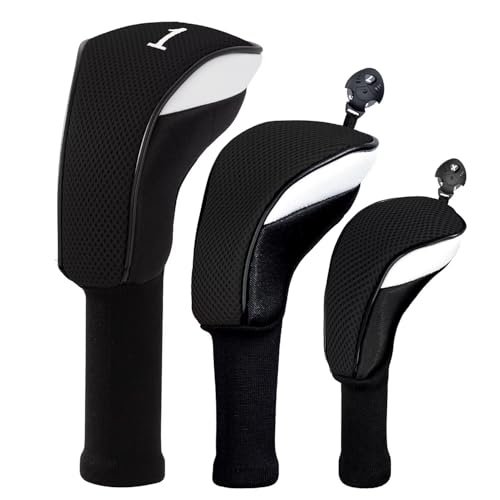Ever wondered why those little dimpled spheres you’re swinging at have numbers on them? It’s not just for show. Golf balls boast those digits for some pretty practical reasons. Whether you’re a seasoned pro or just hitting the links for fun, those numbers can make a difference in your game.

From distinguishing your ball from your buddy’s to aiding in the identification of different models, the numbers on a golf ball serve more than one purpose. They’re part of the game’s tradition and a nod to practicality. Let’s tee off into the world of golf ball numbers and uncover the mystery behind them.
The History of Golf Ball Numbers
You’ve probably noticed those little digits on your golf balls and wondered how they got there. Well, they’re not just for show. The numbers on golf balls have evolved from a functional necessity to what we see today.
Back in the early days of golf, identifying your ball was all about personal marks. Golfers would use their initials, symbols, or even special stamps to claim their ball. As the game grew, so did the need for a more standardized method of identification. This is where numbers started to come into play.
Golf ball manufacturers began producing balls with different numbers, originally as a way to indicate the compression rate of the ball, which affects how soft or hard it is when struck. These numbers could range from 1 to 100, signaling the degree of compression with the lower numbers usually signifying a softer feel.
In time, compression rate marking became less significant and the primary purpose of the numbers shifted towards helping players distinguish their ball from others during play. Typically, a set of golf balls would come with one to four numbers, commonly 1 through 4 or 1 through 9, to provide enough variety for golfers in a match.
Beyond identifying balls, these numbers also developed an element of personal preference and superstition. Some players choose a specific number because it’s lucky for them or it holds sentimental value. Others select their ball number based on the type of score they’re aiming for that day – aspiring for sub-70 rounds with a number 69, for example.
It’s fascinating to see how a simple necessity for identification has woven itself into the fabric of golfing tradition. Every time you pick up a ball with a number that feels right for you, you’re participating in a history that mirrors the evolution of the game itself. And who knows? That chosen number might just bring you a little extra luck as you’re aiming to improve your game and nail those lower scores.
The Purpose of Numbers on Golf Balls
As someone who’s spent a lifetime on the course, you quickly learn that the tiny details can make a significant impact on your game. Those little numbers on golf balls are more than just decoration; they’re there to play a practical role in your gameplay and offer a slight insight into the ball’s characteristics.
First up, the numbers serve as Identifier Tags. In a game where precision reigns supreme, you don’t want to lose track of your ball on the fairway or mistaking someone else’s ball for yours. It can be pretty embarrassing to belt a perfect drive down the middle, only to find out you’ve been following the wrong ball. With numbers on your golf balls, you can effortlessly keep tabs on your shot no matter where it lands — a necessary feature when several balls are in play.
Moving on to the technical aspect, the numbers initially keyed golfers into the Compression Rate of the ball. This is an old-school aspect, though. Nowadays, the number doesn’t relate to compression but knowing the type of ball that suits your swing speed is good lore to have. Lower compression balls, for instance, generally work better if you’ve got a slower swing speed.
Let’s not forget about strategy and superstition, which play an underrated role in golf. Many players pick their ball number based on Personal Preference and Superstition. It might be the number of your favorite sports player, your lucky number, or even the day of the month you were born. This psychological element might seem minor, but it can boost your confidence out on the course.
Lastly, for tournament play, having distinct numbers on golf balls adds another layer of Regulation. Tournament officials can ensure that competitors are adhering to regulations regarding the number of golf balls they are using during the round. Plus, it helps sort out any discrepancies when identifying whose ball is whose after those errant shots we all hope to avoid.
Remember, while the numbers may offer a mental edge or a practical solution for identification, your skill and practice are what ultimately determine your success on the course. Keep a keen eye on your ball and choose your number wisely; it’s part of the subtle art of perfecting your golf game.
Differentiating Your Ball from Your Buddy’s
Imagine teeing off on a beautiful par-3 with your buddies, the sun’s just perfect, and you’ve all got a nice tailwind. You all hit your drives, and what do you know, you’ve all landed on the green. Now you’re walking up, ready to sink that birdie putt, but you’ve got a problem: all the balls are right next to each other. Whose is whose?
This is where the numbers on golf balls earn their keep. They aren’t just there for show; they’re crucial in distinguishing your ball from the rest of your foursome. By checking the number on your ball, you can quickly confirm without a doubt that you’re about to hit the right one.
And here’s a tip from someone who’s been playing this game for years: always make sure to inform your buddies of the number you’re playing with before teeing off. It’ll save time and prevent any mix-ups that could potentially add a penalty stroke to your score.
It’s not just about avoiding penalties, though. Hitting the wrong ball can be a momentum killer, and in a game where mental fortitude is half the battle, you can’t afford errors stemming from a simple oversight. As you aim to improve your game and lower your scores, paying attention to these small details can make a big difference.
Remember, the key to success on the golf course is focus, and being clear about which ball is yours allows you to concentrate fully on your next shot, instead of worrying about identifying your ball. So pick a number that resonates with you, whether it’s lucky number 7 or your anniversary date, and make it your staple. It’s a small act, but it will streamline your game on the greens and fairways. Remember, in golf, every little bit helps.
Identification of Different Golf Ball Models
When you’re out on the course, you’ve probably noticed that not all golf balls are labeled with single-digit numbers. In fact, manufacturers often print different numbers or series on golf ball models to help golfers identify various levels of performance and construction. These numbers aren’t just random—they’re there to inform you about the type and characteristics of the ball.

For instance, if you come across a golf ball with a 90 on it, that’s usually telling you the compression rating of the ball. A higher compression typically indicates a ball suited for players with faster swing speeds—like yourself if you’re working on lowering that handicap. Lower compression balls with labels like 70 or 80 might be targeted towards golfers who have moderate swing speeds.
Let’s take a look at how manufacturers might use numbers in their various models:
- Tour-level balls might be labeled with a 3- or 4-digit number, symbolizing advanced technology or premium offerings.
- Some brands have unique identifiers for their balls, which could include double-digit numbers or a combination of letters and numbers.
By paying attention to these details, you’re not just playing with any old ball—you’re selecting a tool that complements your game. Golf is a game of precision, and the more you know about your equipment, the better you can optimize it for your style of play.
Additionally, manufacturers sometimes release special edition balls or customized numbers for an event or a specific market. If you’re a fan of collecting or just like to stand out with a unique ball, keep an eye out for these limited runs. They’re not only great conversation starters but might just add that extra bit of confidence you need to shave off a stroke or two.
Remember, while a golf ball might seem like a small part of the game, it’s the only piece of equipment you use on every single shot. Make every shot count by choosing a ball that’s designed for your level of play and you’ll be well on your way to hitting those lower scores you’re after.

Numbers and Performance
Navigating the diverse selection of golf balls can be like unraveling a mystery, especially when you’re determined to lower your scores. Here’s a little insider tip: Those tiny numbers can be a key ally in your quest for golfing greatness. Golf ball numbers can tell you a lot about performance and why some balls are favored by fellow low handicappers like myself.
When you’re analyzing a golf ball, you’ll often find numbers ranging from 1-4, or even up to 99. Besides helping to identify your ball, they hold clues about the ball’s construction and the expected performance. Lower numbers generally signify softer feel and lower compression, which can be ideal for more control around the greens.
On the flip side, higher numbers might indicate a firmer construction, hinting at greater distance potential. This can be incredibly useful when tailoring your equipment to your game. You’ve got to choose a ball that suits your swing speed and playing style if you want those birdies to start rolling in.
Here are a couple of things to keep in mind:
- Lower compression balls can benefit slower swing speeds, making them easier to compress and potentially increasing your distance.
- Higher compression balls usually require faster swing speeds but can offer better control for those with the prowess to handle them.
Understanding the interplay between the numbers and their corresponding performance can result in significant improvements in your game. Next time you’re in the pro shop, take a moment to look at the numbers on the golf balls. Reflect on your own game – your swing speed, control needs, and typical course conditions. Acknowledging these elements can contribute to a more informed decision that might just shave a few strokes off your next round. Remember, every little advantage counts when you’re striving for that next level in your golfing journey.

Conclusion
So next time you tee up remember those digits on your golf ball are more than just a way to tell your ball apart from the rest. They’re a key to unlocking a ball that’s tailored to your swing and style. Whether you’re reaching for a soft feel or aiming for maximum distance choose wisely and you’ll be setting yourself up for success on the greens. Don’t forget to give your buddies a heads up about your ball number—it could save you a headache or two down the fairway. Here’s to playing your best game with every round!










